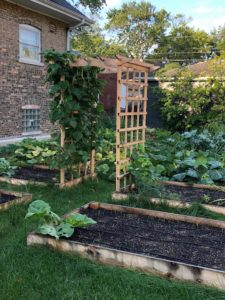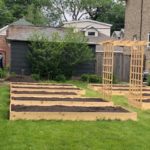 A couple days ago, during a morning walk, I was struck by an unusually situated garden.
A couple days ago, during a morning walk, I was struck by an unusually situated garden.
It was a vegetable garden, not a few flower beds or row of neatly trimmed bushes or patch of ground cover, pleasing to the eye while not needing much attention.
Two rows of wooden frames, containing raised mounds of dirt and greenery of varying heights, sat between two houses. The pieces of wood that served as borders between the vegetables and the rest of the “yard,” if it can be called that, surrounded a trellis.
The trellis might have seemed more fitting to anchor a back yard or public park, as it marked the territory for repose and reflection. It didn’t seem to belong in a vegetable garden. Lettuce and tomatoes, maybe green beans and peppers, grew here.
Why was this garden here, anyway; between two houses, in a space large enough for a house to be built?
I tried to estimate what the property might be worth if it were to be developed and started laughing at myself. A place just for growing things? Imagine that. Imagine that being enough of a purpose.
I thought about how I have gotten used to thinking of commercial impact as defining purpose.
Of course, I considered that whoever owned the property could enjoy salads made from handfuls of arugula brought in to the kitchen only moments before the greens were dressed, but I had a hard time thinking of little perks like this as benefit enough.
I have seen neighborhood gardens where several households took care of their small plot of vegetables within a larger area, but I have never seen a city lot left open like this.
I thought about how the family who assembled the frames and planted the seeds could get special satisfaction from eating something they tended.
The flowers and trees in front of nearby houses could get a little extra sunshine because there was no three-story Tudor or even modest bungalow, creating shade from the space.
Still, it seemed so unusual to me that this space wasn’t used by anyone to make money.
Walking past this lot made me think about time and my life.
For over twelve years, I have been recording reflections of little things from my daily life that filled me with joy or ease, or clued me in on types of experiences I wanted to repeat.
After incorporating this habit as the core of a regular gratitude practice, I started to have a more positive outlook. I saw the good side of things more than not. I felt more confident about exercising choice over where to place my attention.
I decided I wanted to be an example of mindful living and teach people how to use their self-understanding to see how the world was already full of things they could appreciate.
I’ve given some attention to monetizing what I do well; observing my own processes and putting into words how experiences and feelings and attitudes or expectations are connected. Books and workshops and talks became part of my offerings.
When considering these efforts, I have tried to remember that my gratitude practice and knowing how to tap in to my good feelings are enough — like the garden space between these two houses only has to provide room for things to grow, no commercial proof of “value” is required.
Still, I come back to wanting to have a bigger affect in the world.
I decided that it’s okay to want both. I can want to touch other people, even to generate income from doing what I do well, putting everyday events into words, AND fully give myself to experiencing the current moment, recognizing the value in just that.
Lingering in front of this garden, I was struck by the feeling that the vegetables sprouted overnight. I confess that I’ve dreamt about something I’ve posted going “viral,” of becoming an “overnight sensation” myself.
But I know growth doesn’t happen that way. Growth usually requires time and patience and perspective. I had to smile at this unexpected garden, where, according to conventions, a house should be.
Knowing things grow even when progress cannot be seen or measured is no small thing.



Leave a comment